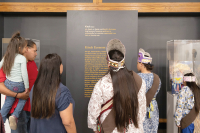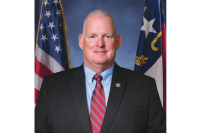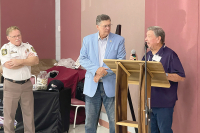Sylva commissions second 2014 study to look into two-way traffic on Main Street
After landing a $10,000 grant from the Southwestern Commission — and putting in $10,000 of its own money — Sylva is waiting on a report to come back from JM Teague Traffic Engineering that will answer that one pivotal question: is two-way traffic on Main Street a no or a go?
“Would it be safe? That’s the main thing,” said Town Manager Paige Dowling. “We don’t want it to cut down on parking or hurt business. Also, in the 1950s Sylva had two-way traffic but cars are bigger now, as are trucks. With Main Street being a highway, could trucks make the turn on Main Street if it were to be two-way?”
Main Street has been down this road before. The N.C. Department of Transportation conducted a similar study earlier this year … and in 1996 … and in the 1970s.
But Main Street has stayed one-way since first making the switch more than half a century ago. The reason, said Reuben Moore, the traffic engineer who did the study earlier this year for the DOT and is now working for Teague, likely lies — at least partially — in the tug-of-war between town and DOT interests.
“The owner of the road is still the state department of transportation, which still has the mission of moving traffic,” said Moore, who worked for the DOT until joining Teague earlier this year. “It’s hard to argue that it [one-way traffic] is not the most efficient way to move traffic, because it is. You can set up better signal progression, you can use lanes for exclusive left or right turns.”
But from the town perspective, two-way roads are better for business. They create a slower road, which makes a safer environment for pedestrians, and they make it easier for shoppers to reach a particular business.
Related Items
“Businesses feel like they’re more accessible if you can get to them from either direction of the street,” Moore said.
That’s definitely the case, Dowling said, but having two-way traffic would also mean that cars would be able to drive toward Jackson County Courthouse, considered the crown jewel of downtown, and enjoy the view. The fact that all traffic now moves away from the courthouse has long been a thorn in the town’s side.
Of course, being able to engineer the two-way traffic so it can happen safely will be the first priority. Cars are bigger now than in the 1950s, and as a state highway, downtown also has to accommodate tractor-trailer traffic. Those vehicles require wide births for travel and turning, so Moore will have to determine if there’s space to allow for that with traffic traveling both ways.
That’s the consideration that tabled a similar effort in Canton, which also used to have a two-way street before changing to one-way, in the early 2000s.
“Looking at reports from DOT and measurements for the tractor trailers and things, we would be losing some infrastructure and buildings there on Park Street, so at that time it was just put on hold, just kind of put up somewhere,” said Canton Mayor Mike Rey.
And from a volume perspective, two-way traffic could be a bit more of a challenge in Sylva than in, say, Waynesville, because Sylva doesn’t have any side streets that run directly parallel to Main and Mill, Moore said. A key to success in two-way street towns is having alternative routes to take pressure off of Main Street.
“Both Hendersonville and Waynesville have parallel streets on the side that can take a lot of the through traffic off of Main Street,” Moore said. “Sylva doesn’t have a street that you can use as an equivalent bypass.”
It’s arguable that U.S. 74 is an alternative traffic route, Moore said, but taking that road does mean leaving downtown entirely and traveling about three times as many miles. On the other hand, you can drive 60 miles per hour as opposed to 20 downtown. Part of Moore’s study involves traffic counts and predicting where traffic would move if lanes were configured in different ways.
He’ll also be looking to conserve pavement in order to keep the parking space count as high as possible. Right now, the parking spaces are aligned at a 30-degree angle to the road, an orientation that means they take up a lot of curb space, cars jut far out into the road and drivers have to back out blind. Changing some of those spaces to parallel or reverse-angle parking, or changing the angle of the diagonal spaces to 45 degrees — those take up less space on the curb and are easier to back out of — could be solutions.
Moore will also consider taking out a lane on Mill Street, which parallels Main and is also one-way, to use for parking. A section of the lane is now closed following a fire in downtown Sylva this summer, and after getting some favorable responses to the new parking area, the town decided to add that consideration into the study.
“We’re getting lots of positive feedback about diagonal parking and one-lane on Mill Street,” Dowling said.
Another positive, Moore said, is the whole reason behind the push over the past several years to re-envision downtown traffic patterns in Western North Carolina. Though it’s challenging to fit narrower, older streets to the needs of 21st-century traffic, the call to do so comes from a good place.
“I’ve lived in Jackson County for 29 years, and I know when I first lived here, most of the downtowns had almost no business at all,” he said. “After five o’clock there was absolutely nothing going on. Now you have a lot of specialty shops, a lot of tourism, breweries in almost every little town.”
By the time March 2015 rolls around, the study will be done and both Moore and the town of Sylva will have a better idea of whether two-way traffic will become a reality to support that trend in Sylva.









